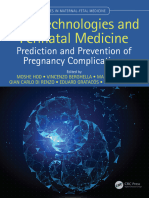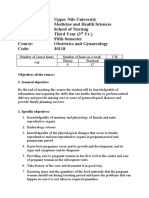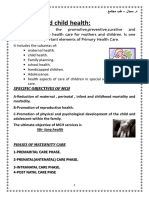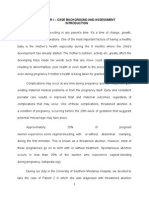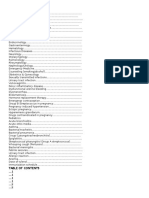Obstetrics & Gynecology: Course Objectives
Obstetrics & Gynecology: Course Objectives
Uploaded by
pavi7muruganathan0 ratings0% found this document useful (0 votes)
56 views3 pagesThis document outlines the course objectives and topics for a 12-week course in obstetrics and gynecology. The 13 objectives cover participating in reproductive health programs, diagnosing and managing common obstetric and gynecological disorders, counseling patients, and handling related legal and ethical issues. The course is taught by 4 faculty members and covers topics such as normal pregnancy management, labor, menstrual disorders, gynecological symptoms, pregnancy complications, and abnormal labor.
Original Description:
protocol
Original Title
OBG
Copyright
© © All Rights Reserved
Available Formats
PDF, TXT or read online from Scribd
Share this document
Did you find this document useful?
Is this content inappropriate?
Report this DocumentThis document outlines the course objectives and topics for a 12-week course in obstetrics and gynecology. The 13 objectives cover participating in reproductive health programs, diagnosing and managing common obstetric and gynecological disorders, counseling patients, and handling related legal and ethical issues. The course is taught by 4 faculty members and covers topics such as normal pregnancy management, labor, menstrual disorders, gynecological symptoms, pregnancy complications, and abnormal labor.
Copyright:
© All Rights Reserved
Available Formats
Download as PDF, TXT or read online from Scribd
Download as pdf or txt
0 ratings0% found this document useful (0 votes)
56 views3 pagesObstetrics & Gynecology: Course Objectives
Obstetrics & Gynecology: Course Objectives
Uploaded by
pavi7muruganathanThis document outlines the course objectives and topics for a 12-week course in obstetrics and gynecology. The 13 objectives cover participating in reproductive health programs, diagnosing and managing common obstetric and gynecological disorders, counseling patients, and handling related legal and ethical issues. The course is taught by 4 faculty members and covers topics such as normal pregnancy management, labor, menstrual disorders, gynecological symptoms, pregnancy complications, and abnormal labor.
Copyright:
© All Rights Reserved
Available Formats
Download as PDF, TXT or read online from Scribd
Download as pdf or txt
You are on page 1of 3
3.
OBSTETRICS & GYNECOLOGY
COURSE OBJECTIVES:
At the end of the course the student should be able to:
1. Participate in all national health programs and policies related to reproductive
health and safe motherhood.
2. Define terms commonly used in obstetrics and gynecology.
3. Demonstrate skills of history taking and performing obstetric and gynecological
examination in order to arrive at a logical diagnosis.
4. Recognize clinical features of common obstetric and gynecological disorders
correlate these with etio-pathology and institute primary management.
5. Diagnose pregnancy and provide antenatal, natal, post-natal and essential newborn
care.
6. Identify high risk pregnancy, provide primary care and refer to appropriate medical
centres.
7. Prescribe drugs judiciously during pregnancy and lactation.
8. Screen women for genital and breast cancer for early diagnosis and prevention.
9. Counsel and guide patients and family regarding illness, care, possible complications
and prognosis.
10. Counsel couples and provide fertility regulation.
11. Acquire and practise communication skills required for taking informed consent and
providing reproductive health care to women.
12. Handle medico-legal and ethical issues related to obstetrics and gynecology.
13. Diagnose and provide primary care of common obstetric and gynecological
emergencies.
Course Duration: 12 Weeks
Faculty:
Dr.Lucio Pedro - HoD
Dr. Geremias De Oliveira Rangel
Dr. Ahmad R N Rozan
Dr. Narine Singh
Topics:
I. Introduction to obstetrics and gynaecology
1. Terms used in obstetrics, gynaecology and fertility
regulation.
2. Demography
3. National health policy for reproductive health care and safe motherhood.
II. Management of Normal Pregnancy
1. Development of placenta and development and growth of foetus.
2. Maternal adaptation to pregnancy.
3. Diagnosis of pregnancy.
4. Screening for high risk pregnancy.
5. Fetal surveillance for growth and well being.
III. Management during labour
1. Mechanism of normal labour.
2. Intrapartum monitoring and use of partogram.
3. Pain relief during labour.
4. Management of normal delivery.
5. Management of third stage.
IV. Menstrual function and dysfunction
1. Menstrual disorders
2. Dysmenorrhoea
3. Abnormalities of menarche and menopause
V. Common Gynecological Symptoms
1. Vaginal discharge
2. Pain abdomen.
3. Abdominal mass.
4. Utero-vaginal prolapse.
VI. Complications in Pregnancy Complications of early Pregnancy Abortions
1. Abortions
2. Ectopic pregnancy
3. Gestational trophoblastic tumors
4. Hyperemesis gravidarum
5. Retention of urine
6. Multiple pregnancy
7. Malpresentations
8. Antepartum Haemorrhage
9. Pregnancy induced hypertension and eclampsia
10. Pretem labour and premature rupture of membranes.
11. Intracuterine growth retardation.
12. Rh isoimmunisation.
13. Intrauterine fetal death
14. Repeated pregnancy loss.
15. Anaemia
16. Hypertensive disorders
17. Renal disorders
18. Cardio vascular disorders
19. Diabeties mellitus
20. Jaundice
21. Malaria
22. Tuberculosis
23. Syphilis
24. TORCH infections
25. AIDS
VII. Abnormal Labour
1. Prolonged labour
2. Obstructed labour
3. Assisted delivery
4. Breech delivery
5. Forceps delivery
6. Vento use delivery
Caesarean section
7. Version (I.P.V.)
8. Destructive operations
9. Post partum haemorrhage
10. Manual removal of placenta
11. Birth canal injuries
You might also like
- Fluid & Electrolytes Cheat Sheet v3Document1 pageFluid & Electrolytes Cheat Sheet v3faten100% (2)
- Introduction To Concept of Obstetrical NSGDocument11 pagesIntroduction To Concept of Obstetrical NSGswethashaki100% (2)
- OBDocument7 pagesOBJune DianNo ratings yet
- Incomplete Abortion MINI CASE STUDY (Group 3)Document22 pagesIncomplete Abortion MINI CASE STUDY (Group 3)Twobee Evelyn Claire62% (21)
- Obs and GyneDocument20 pagesObs and Gynejencia gnanaprakasamNo ratings yet
- M.S. Obstetrics & Gynaecology 2020Document32 pagesM.S. Obstetrics & Gynaecology 2020Dr.Udhayakumar sNo ratings yet
- All India Institute of Medical Sciences Nagpur Department of Obstetrics and GynecologyDocument19 pagesAll India Institute of Medical Sciences Nagpur Department of Obstetrics and GynecologySugan GavaskarNo ratings yet
- Ms Osg Curriculum Syllabus 2018Document36 pagesMs Osg Curriculum Syllabus 2018Dr. Aditya ShindeNo ratings yet
- Modified SOP of MidwivesDocument10 pagesModified SOP of MidwivesEmmanuel JNo ratings yet
- Obsterics & Gyneacology Prep Manual For Undergraduates - E-BookDocument156 pagesObsterics & Gyneacology Prep Manual For Undergraduates - E-BookVirendra K. GajbhiyeNo ratings yet
- (Series in Maternal-Fetal Medicine) Moshe Hod_ Vincenzo Berghella_ Mary D’Alton_ Gian Carlo Di Renzo_ Eduard Gratacós_ Vassilios Fanos - New Technologies and Perinatal Medicine_ Prediction and PreDocument265 pages(Series in Maternal-Fetal Medicine) Moshe Hod_ Vincenzo Berghella_ Mary D’Alton_ Gian Carlo Di Renzo_ Eduard Gratacós_ Vassilios Fanos - New Technologies and Perinatal Medicine_ Prediction and Predr.davidoktavianusspog100% (1)
- Comprehensive Evaluation of Pregnancy Complications at A Tertiary Care Teaching HospitalDocument9 pagesComprehensive Evaluation of Pregnancy Complications at A Tertiary Care Teaching HospitalIJAR JOURNALNo ratings yet
- Obstetrics & Gynaecology PDFDocument15 pagesObstetrics & Gynaecology PDFViditchoure Viditchoure100% (1)
- APSA Fetal Handbook 2019Document92 pagesAPSA Fetal Handbook 2019Fabrício GonzagaNo ratings yet
- The Prospective Mother, a Handbook for Women During PregnancyFrom EverandThe Prospective Mother, a Handbook for Women During PregnancyNo ratings yet
- BPH313Family and Reproductive Health Group 9 Presentation, SID 027-491Document17 pagesBPH313Family and Reproductive Health Group 9 Presentation, SID 027-491duku mosesNo ratings yet
- Course Specification: University: Al Azhar Faculty: Medicine Department: Obstetric & GynacologyDocument12 pagesCourse Specification: University: Al Azhar Faculty: Medicine Department: Obstetric & GynacologyMontadher Abdul AzimNo ratings yet
- Course Syllabus-Maternity TheoryDocument6 pagesCourse Syllabus-Maternity TheoryannairishybNo ratings yet
- Obstetrics Gynecology Competencies e PDFDocument22 pagesObstetrics Gynecology Competencies e PDFمركز ريلاكس للعلاج الطبيعيNo ratings yet
- 2010 GYN ModuleDocument36 pages2010 GYN Modulelolapell100% (1)
- SDL ActivitiesDocument11 pagesSDL Activitiesella retizaNo ratings yet
- ManualObstetrics 2021 InperDocument56 pagesManualObstetrics 2021 InperScribdTranslationsNo ratings yet
- The Management of Second Trimester MiscarriageDocument30 pagesThe Management of Second Trimester MiscarriagexxdrivexxNo ratings yet
- Preventive Obstetrics (By Mohan.s)Document52 pagesPreventive Obstetrics (By Mohan.s)mOHAN.S98% (55)
- Course Outline NursingDocument5 pagesCourse Outline Nursingkitekite562No ratings yet
- Obstetrics and GynaecologyDocument7 pagesObstetrics and GynaecologyCherry KolaNo ratings yet
- Obstretics NDocument7 pagesObstretics NFojal AhmedNo ratings yet
- OBGY NursingDocument5 pagesOBGY NursingAdaha AngelNo ratings yet
- Management of Multiple PregnancyDocument14 pagesManagement of Multiple PregnancyxxdrivexxNo ratings yet
- Sr. No. Subjects of Study A Obstetrics (Theory)Document2 pagesSr. No. Subjects of Study A Obstetrics (Theory)rumi bhandariNo ratings yet
- Obstetric Nursing & Midwifery 2 Course OutlineDocument2 pagesObstetric Nursing & Midwifery 2 Course OutlineCrevins NyarikiNo ratings yet
- Seminar On PRVNTV ObgDocument43 pagesSeminar On PRVNTV Obgraghuram reddyNo ratings yet
- MUHS OBG SylabusDocument10 pagesMUHS OBG SylabusnavneetmagonNo ratings yet
- MCN Case Presentation Group 2 1Document68 pagesMCN Case Presentation Group 2 1Mary-Ann JagonobNo ratings yet
- Final Case Presentation Group 9 2nd RotationDocument105 pagesFinal Case Presentation Group 9 2nd Rotationjanaquintela58No ratings yet
- Protocol Poojitha CompletedDocument15 pagesProtocol Poojitha CompletedPranav SNo ratings yet
- Coovadia BOK 382 Neonatal PaediatricsDocument57 pagesCoovadia BOK 382 Neonatal Paediatricsu20433621No ratings yet
- Final For Grandcaseg3b-2 Case Study-Or DR ComplexDocument34 pagesFinal For Grandcaseg3b-2 Case Study-Or DR ComplexJervy Emiel VALENCIANo ratings yet
- KSM ObsgynDocument16 pagesKSM ObsgynFakhrul RoziNo ratings yet
- Antenatal Care PPT EchyDocument14 pagesAntenatal Care PPT EchyYuliana alensi falloNo ratings yet
- CASE-STUDY-FINAL-G4Document40 pagesCASE-STUDY-FINAL-G4sphclvrNo ratings yet
- Maternal and Child Health:: Ž RefersDocument9 pagesMaternal and Child Health:: Ž RefersAbo Amgad100% (1)
- EMONCDocument17 pagesEMONCJessie OranoNo ratings yet
- Gestational ProblemDocument75 pagesGestational ProblemWillard Jade FaustinoNo ratings yet
- Unit 1 Dimensions of MCHDocument5 pagesUnit 1 Dimensions of MCHLondera BainNo ratings yet
- PreeclampsiaDocument58 pagesPreeclampsiarhyanne100% (8)
- Pmaternal CareDocument152 pagesPmaternal CareNatia Demetradze100% (1)
- Chapter I - Case Background and AssessmentDocument21 pagesChapter I - Case Background and AssessmentJuhainie Dipatuan MagundacanNo ratings yet
- Micro TeachingDocument23 pagesMicro Teachingsiti harningsih safitriNo ratings yet
- Care of The Well NewbornDocument17 pagesCare of The Well NewbornGermán López Valencia100% (1)
- Gyne Lecture NoteDocument572 pagesGyne Lecture NoteMRT RadiologyNo ratings yet
- Curriculum: FOR Obstetrics/Gyn AecologyDocument42 pagesCurriculum: FOR Obstetrics/Gyn Aecologyप्रधुम्नमहतNo ratings yet
- Seminar M.SC Unit 1 FinalDocument68 pagesSeminar M.SC Unit 1 FinalDharaniNo ratings yet
- GROUP 6 TDH DR Case Presentation 1Document92 pagesGROUP 6 TDH DR Case Presentation 1Britz Ronquillo MintaNo ratings yet
- GDM Final CP OutputDocument77 pagesGDM Final CP OutputJannah Chriestel TauthoNo ratings yet
- NCM 109 Care of Mother and Child at RiskDocument10 pagesNCM 109 Care of Mother and Child at RiskMia Fe Cuaya Lorenzo100% (1)
- NCM 109 Care of Mother and Child at RiskDocument10 pagesNCM 109 Care of Mother and Child at RiskMia Fe Cuaya Lorenzo100% (1)
- Inevitable AbortionDocument21 pagesInevitable AbortionJaysonPangilinanAbanNo ratings yet
- OBG IA EditDocument3 pagesOBG IA EditTushar GuptaNo ratings yet
- 2antenatal CareDocument10 pages2antenatal CareuouoNo ratings yet
- Anat RR 1Document24 pagesAnat RR 1pavi7muruganathanNo ratings yet
- All India Institute of Medical SciencesDocument1 pageAll India Institute of Medical Sciencespavi7muruganathanNo ratings yet
- Physio INI PYTDocument4 pagesPhysio INI PYTpavi7muruganathanNo ratings yet
- Notification Assistant Surgeon GeneralDocument25 pagesNotification Assistant Surgeon Generalpavi7muruganathanNo ratings yet
- OnlineEC Instruction MDMS 2022 23Document2 pagesOnlineEC Instruction MDMS 2022 23pavi7muruganathanNo ratings yet
- 15A ArteryDocument72 pages15A Arterypavi7muruganathanNo ratings yet
- Development Urinary SystemDocument33 pagesDevelopment Urinary Systempavi7muruganathan75% (4)
- Cleavage and ImplantationDocument20 pagesCleavage and Implantationpavi7muruganathanNo ratings yet
- 2-Complications of Pregnancy Pt1Document37 pages2-Complications of Pregnancy Pt1pavi7muruganathanNo ratings yet
- AsphyxiaDocument48 pagesAsphyxiapavi7muruganathanNo ratings yet
- Hypertensive Diseases in Pregnancy: DR Lucio Pedro DM MD FacogDocument32 pagesHypertensive Diseases in Pregnancy: DR Lucio Pedro DM MD Facogpavi7muruganathanNo ratings yet
- AsphyxiaDocument19 pagesAsphyxiapavi7muruganathanNo ratings yet
- Done Uterine RuptureDocument3 pagesDone Uterine RupturejnapalaNo ratings yet
- Daftar Obat Di RS Mitra SehatDocument11 pagesDaftar Obat Di RS Mitra SehatLina NdItink BreBiringNo ratings yet
- Uworld Notes.2 Rounds TPDocument14 pagesUworld Notes.2 Rounds TPjuli100% (1)
- HPN DM RegistryDocument9 pagesHPN DM RegistryBorbe ClauNo ratings yet
- Bahasa InggrisDocument15 pagesBahasa InggrisThyna ARNo ratings yet
- Gambaran Pengetahuan Keluarga Dengan Diabetes Melitus Tentang Pencegahan Komplikasi Diabetes Melitus Di Wilayah Kerjapuskesmas Sentolo 2Document10 pagesGambaran Pengetahuan Keluarga Dengan Diabetes Melitus Tentang Pencegahan Komplikasi Diabetes Melitus Di Wilayah Kerjapuskesmas Sentolo 2Ega ApriliaNo ratings yet
- Centro Escolar University Makati Campus Department of Nursing 2 SEM 2019-2020 BSN 2asDocument2 pagesCentro Escolar University Makati Campus Department of Nursing 2 SEM 2019-2020 BSN 2asmyeonnieNo ratings yet
- Antiulcer DrugsDocument16 pagesAntiulcer DrugsJenNo ratings yet
- Nutrilite Diet Supplementsin FinalDocument2 pagesNutrilite Diet Supplementsin FinalAnisur RehmanNo ratings yet
- Drug Study: Therapeutic Class: Antilipemics Pharmacologic Class: Hmg-CoaDocument8 pagesDrug Study: Therapeutic Class: Antilipemics Pharmacologic Class: Hmg-CoaKristine YoungNo ratings yet
- Obstetrics and GynaecologyDocument31 pagesObstetrics and GynaecologyLana LocoNo ratings yet
- VXL-List of Pharma Products (Domestic and Export)Document10 pagesVXL-List of Pharma Products (Domestic and Export)Singh PushpanjaliNo ratings yet
- Drug Study - Amiodaron HydrochlorideDocument4 pagesDrug Study - Amiodaron HydrochlorideTwinkle SalongaNo ratings yet
- Drugs Pediatrics PDFDocument32 pagesDrugs Pediatrics PDFNaveen KovalNo ratings yet
- Speech About: BronchopneumoniaDocument4 pagesSpeech About: Bronchopneumoniadiana ratriNo ratings yet
- Drug and ClassificationDocument4 pagesDrug and ClassificationdavidcalaloNo ratings yet
- Infectious MononucleosisDocument7 pagesInfectious MononucleosisNandkumar ChinaiNo ratings yet
- Your Medication Schedule: The 12-Dose Regimen For Latent Tuberculosis (TB) InfectionDocument2 pagesYour Medication Schedule: The 12-Dose Regimen For Latent Tuberculosis (TB) InfectionJuan Miguel PangilinanNo ratings yet
- Antimicrobial AgentDocument46 pagesAntimicrobial Agentسامر الرفاعيNo ratings yet
- Osce QuestionsDocument128 pagesOsce Questionsdean100% (1)
- High Yield Obs & GynaeDocument84 pagesHigh Yield Obs & GynaeDrive RashNo ratings yet
- BPS 2143 PharmacologyDocument15 pagesBPS 2143 PharmacologyBella AstilahNo ratings yet
- NO. Nama Obat Berbeda Kemasan Mirip SediaanDocument2 pagesNO. Nama Obat Berbeda Kemasan Mirip Sediaaneki_megarani100% (1)
- Antibiotics: How Much Do You Know? Try Our Quiz For PrescribersDocument6 pagesAntibiotics: How Much Do You Know? Try Our Quiz For PrescribersSupratim SahaNo ratings yet
- Paramedic Drugs: Drug Class Indications Dosage NameDocument14 pagesParamedic Drugs: Drug Class Indications Dosage NameIbrahem Al100% (8)
- Schema Vaccinare CanadaDocument2 pagesSchema Vaccinare CanadaCatalina VisanNo ratings yet
- Sulfonamide Drug StudyDocument1 pageSulfonamide Drug StudyMenard VelascoNo ratings yet
- Gastro Inter It IsDocument3 pagesGastro Inter It IsDhea Imas WijayantiNo ratings yet
- Congestive Heart FailureDocument5 pagesCongestive Heart FailureKaren PanganibanNo ratings yet










